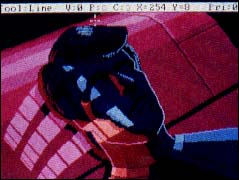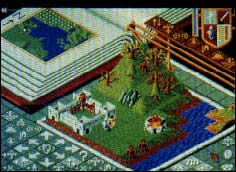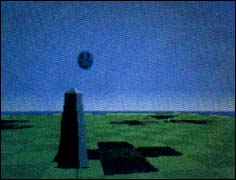For The Fun Of It
Strange New Worlds to Conquer
Into outer space, on Mt. Olympus, or on a weird archipelago, START's stalwart game reviewers take you everywhere this issue. Game quality and originality are excellent in these three offerings from some of the best game publishers in the business. So sit back, read and then check the available balance on your credit card--you'll probably want all three!
SPACE QUEST III, THE PIRATES OF PESTULON
Reviewed by David Plotkin
Space Quest III: The Pirates of Pestulon is the second sequel in Sierra's popular Space Quest Series. It incorporates elements of standard text adventures with excellent graphics and animation to provide a playable and not-too-difficult adventure. It would be particularly suitable for people just getting their first taste of adventure gaming.
When Last We Met ...
Space Quest III picks up where Space Quest II leaves off. The hero, a fellow named Roger Wilco, is adrift in space in suspended animation. His space pod, which he used to escape from Sludge Vohaul (the villain in Space Quest II) is picked up by a passing garbage freighter. This awakens Roger, whose goal it becomes to escape from the freighter. To further complicate his life, Arnoid the Annihilator is after Roger for a minor debt of 400,000 buckazoids--a fortune in any galaxy! On top of that, the Two Guys from Andromeda (incidently, the authors of this program) have been kidnapped by Scumsoft, a software company with a very poor reputation.
 |
Sierra On-Line's Space Quest III out-sillies its predecessors. |
Roger Wilco is guided around the screen through the mouse, arrow keys, or number pad. The number pad is actually the easiest to use because it gives the finest control, allowing access to accurate diagonals. As with other Sierra programs, Roger can walk around and behind objects, climb up and jump down from them. The speed of the game is variable from a menu bar that appears only when you press the right mouse button. Other than moving Roger, all commands are given via text input. As you begin to type, a small text window appears on the screen, where you can type in your commands. The parser is quite advanced and can generally figure out multiple commands.
As always with this type of adventure, however, you must phrase your commands exactly right or you get a "don't understand" reply (a silly one to be sure, but one, nonetheless). Unfortunately, things continue to happen as you struggle to come up with the correct phrasing. For example, poor Roger continues to move down the conveyor belt toward the metal-crushing machine as you try to tell him to get the heck off the conveyor belt. Gets real messy if you don't figure it out in time.
Excellent Graphics
The graphics and animation in Space Quest III are excellent. Characters are animated through many frames, making motion smooth and believable. As you guide Roger around the screen, he even has a shadow in the lighted parts, and gets smaller if you move him farther away toward the back of the current room. The price you pay for all this is that each new room (and its associated animations) must be loaded from disk, an interminable process if you're using floppy disks.
The game itself is distributed on three double-sided disks. If you have only a single-sided disk drive, you can send for the game in that format by paying an extra $10. But since the game is not copy-protected, you can load the whole mess on your hard disk if you have one, which cuts the load time for each screen considerably. Space Quest III's sound is excellent and features something new: MIDI support. Plug a MIDI synthesizer, such as the popular Casio CZ101, into your machine and you can hear the musical score written by Bob Siebenberg of Supertramp through it. It sounds tremendous.
Outrageously Silly
All of the Space Quest series have had a touch of silliness, but Space Quest III is the most outrageous of them all. Everywhere you turn, there's off-the-wall humor. If you fall off a ledge, you get a humorous message accompanied by a graphic you won't soon forget. The "Worlds O' Wonder" sequence on a planet called Phleebhut and the Astro Chicken arcade game are my two favorites, but the game is laced with subtle silliness. For example,inside the destroyed head of an awesome battle robot are several giant Tinker toys! The Starship Enterprise makes an appearance, and Roger even does an imitation of the Honeymooner's Ralph Kramden (the character immortalized by Jackie Gleason).
There's but one caveat for people considering the purchase of this fine piece of software. When you sweep away the superb musics, animation and graphics, this is essentially a text adventure. You must solve puzzles and second-guess the parser, and get killed lots of times trying to figure out how to get past one hazard or another. In the process, you'll load the same screens over and over again, and watch the same animation ending in the same result many times. Keep this in mind and you won't go wrong. But for lovers of adventure games and people wondering what all the excitement is about, this game is highly recommended.
POPULOUS
Reviewed by Andrew Reese
START Editor
There are a number of classic types of computer games: paddle ball, scrolling shoot-em-ups, flight simulators--and role playing games. In good RPGs, artful programming lets a player assume a different persona to fight evil or find a hidden treasure. But the ultimate role to be played on a computer has to be that of a god. And Electronic Arts' new import from England, Populous, lets you take just that role.
 |
In the close-up map in the foreground, the walkers who worship you (their god) spread out over the landscape to settle and raise families--who will also worship you, of course. The goal of Pop- ulous is to guide, cajole and force your own fol- lowers into out-settling and out-fighting your rival's followers. All kneel! |
In Populous, you are a god, complete with followers, whom you, of course, desire to favor. But you are not the only god in the universe. If you have chosen to be a good god, there's an evil god scheming to overwhelm your flock. Or you can choose to be an evil god and fight against good. Your opponent can be either the computer or another human on a second ST connected via a Hayes-compatible modem.
Modes of Play
There are two modes of play in Populous, Custom and Conquest. In the Custom mode, you can set a number of variables prior to the game to handicap yourself or your opponent. For example, a divine being can cause earthquakes or volcanoes to disrupt a rival's followers, but these godly powers can be disabled at your choice. If you're playing the Conquest series of nearly 500 predesigned worlds, you can't change the setup. Your challenge is to beat the computer in a series of ever more difficult worlds with fewer and fewer powers available yourself.
Populous uses a unique interface and display that show a great deal of care in their design. The basic playfield is a close-up 3-D map, shown in three-quarter view. Across it, your followers wander, build houses and castles and fight battles against their (and your) foe. In the upper-left corner of the screen is the Book of Worlds, an overall map that you can use to keep track of settlements and topography and to move the close-up map to another area quickly.
Around the close-up map are a number of icons that you can select to influence the behavior of your followers, to zoom the close-up window to a specific location or to cause cataclysms, such as floods, swamps, earthquakes or volcanoes.
In the upper right of the screen is a manna bar that shows your power (manna). Next to it is an Information Shield that keeps track of the two follower populations and specifics about settlements, combatants or walkers. (Walkers are those followers of yours who wander out across the landscape settling new territory.)
Populous is played entirely with the mouse. Depending upon which command is active (and how much manna or power your followers have gained for you), you can raise or lower land, place your Papal Magnet, | create a knight or cause a disaster. In order to encourage your followers to settle, breed more followers and add to your follower population (and manna), you must level out the area where your walkers or their settlements are. The greater the flat area, the larger the settlement your followers will build, and the greater will be your power.
Don't Die in the Desert
There are a great many subtleties in Populous. Depending upon which of the four types of terrain exists in the world, your walkers may die more easily or your population may increase more slowly. You must adopt a strategy that fits the world you're in--and that takes some experimenting. But since you can complete most games in less than a half hour, experimentation time is not a problem, it's a pleasure.
There is only one goal in Populous: to defeat your rival god. As you move about the landscape creating lands for your followers and disrupting your rival's civilization, you'll see your opponent trying to do the same to you. If you're clever, you'll eventually gain the upper hand and start to build a population edge. When your population reaches a peak, you can call for the ultimate battle, Armageddon, and the game will be resolved in one clash between the leaders.
Populous has a mild form of on-disk copy protection that gave no loading problems and didn't threaten to tear the head off my drive. No off-disk type-ins are necessary. If you have a double-sided "A" drive, you'll have some added music at start-up and digitized voices during the play; with a single-sided drive, you lose these effects--but it's not a great loss, anyway. The greater loss is the theme music and heartbeat from the Amiga version.
You can save a game in progress and return to it at any time, an extremely desirable feature in a game with some 500 levels (and 128,000 possible world combinations). Bullfrog, the English software group that designed Populous, seems to have thought of everything. Kudos especially to Peter Molyneux, the creative force behind Populous.
Populous is a fascinating, fun and challenging game. It's unlike any other computer game I've ever seen, ever. Don't miss it, unless you're a dyed-in-the-wool arcade gamer who has no time for strategy.
ARCHIPELAGOS
Reviewed by Carolyn Cushman
In the far future, Earth has been poisoned and it's up to you to purify the land in Archipelagos from Britannica Software. The island chains (or archipelagos) you'll visit come in the most imaginative shapes, but have been poisoned and perverted. To cleanse the islands you must seek out and destroy the power nodes scattered about and the obelisks that control them. On each archipelago a single black obelisk controls the nodes. A node can be destroyed only if land connects the node and obelisk, so you must build bridges of land between the islands.
Strategy
Archipelagos strategy varies with the layout of each set of islands. First, you need to locate the obelisk and nodes and work out the most efficient means of connecting the islands and nodes. Then you must also look out for the strange creatures inhabiting the islands, which do their best to make your job difficult. At first, the only dangerous creatures are the Viral Trees, which slowly move toward you, infecting the ground as they go.
Then there are the Necromancers beginning in Archipelago 13. These giant eyeballs rise out of the land, then sink down again, turning good land to sand, and sand to water, eating away your landbridges faster than you can build them. On level 20 the Eco-Eggs first appear, poisonous to touch, but not mobile. When they hatch, however, the eggs spill out deadly red poisons, flooding any connected islands. A more mobile nuisance, the Aircleaners appear on Archipelago 25. These erratic but deadly red whirlwinds careen from side to side on their islands. However, like the rest of the denizens of these islands, these whirlwinds are neither fast nor intelligent enough to be serious threats--as long as you keep moving.
You can spend as much time, or as little, in any session as you want. Despite some notable exceptions, few levels take more than 20 minutes to complete, and many take less. Once you complete a level, that information is recorded on the disk, and the next time you play you can go straight to the next level, if you want.
 |
With up to 9,999 levels, Archipela gos, from Britan- nica Software, offers even the most ardent game-player hours of chal- lenging fun. |
Bizarre Designs
After the first few archipelagos, the difficulty increases rapidly, then levels off. The strategic problems vary enough to keep the game challenging, even intriguing, as you tackle some truly odd island chains. Particularly entertaining, every fifth level up to Archipelago 100 has a specially designed shape, including a butcher's chart of a pig (level 20), the outrageous "Wanted Dead or Alive--Tony's Barber" (level 85) and maps of Europe (level 50) and the United States (level 25).
Once you complete Archipelago 100, you're free to select any archipelago from 1 to 9,999. However, without the specially designed worlds to add interest, and without any significant increase in difficulty, the upper levels can prove quite similar to one another.
The vivid and weird graphics capture the spirit of the game. The eerie landscape is a simple, clashing checkerboard of poisonous reds and right greens set against a grey sky and vivid blue water, inhabited by twisted creatures drawn in creepy detail. Full of strange reverberations and eerie melodies, the sound also helps create an appropriate, ominous mood--and warns of the presence of certain creatures.
Function keys are used to create land, view a map or perform a quick U-turn. Other movements are controlled by mouse, with a simple point and click technique used to move from square to square or to collapse nodes. Smooth scrolling enhances the very convincing illusion of 3-D space and movement across the islands. However, you seem to float above the ground, always looking straight ahead. Anything beneath you, even a few squares away, is hidden--an annoying and potentially fatal problem.
Lasting Impressions
The manual includes basic instructions, a guide to the island lifeforms, some tips and hints--and four pages filled with a numbered grid that provides the game's copy protection. (You'll want really good lighting to read those tiny numbers printed on dark red-brown paper.)
Overall, Archipelagos is one of the most original games I've seen, both in gameplay and in overall concept. The sharp graphics and music combine to provide an odd and eerie setting that works despite an essentially forgettable scenario. Despite the seek-and-destroy nature of the game, this is no shoot-em-up, but rather a futuristic fantasy strategy game. If you like graphically vivid puzzles, or truly weird challenges, Archipelagos is definitely worth checking out.
Contributing Editor David Plotkin works as a chemical engineer for Chevron U.S.A. Carolyn Cushman is the Associate Editor of Amiga Plus and Antic magazines. This is her first review for START.
PRODUCTS MENTIONED
Space Quest III: The Pirates of Pestulon, $59 95. Sierra On-Line Inc. P.O. Box 485, Coarsegold CA 93614, (209) 683-4468.
Populous, $49 95. Electronic Arts, 1820 Gateway Drive, San Mateo, CA 94404, (800) 245-4525.
Archipelagos, $39.95. Britannica Software, 345 Fourth Street, San Francisco, CA 94107, (415) 546-1866.